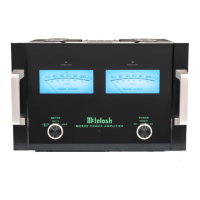
Do you have a question about the McIntosh MC602 and is the answer not in the manual?
Covers reading instructions, warnings, and avoiding hazards like moisture and shock.
Covers ventilation, heat sources, water proximity, and proper mounting.
Covers plug polarity, extension cords, and protecting power cords.
Covers polarized/grounding plugs and disconnecting power.
Covers cleaning, liquid avoidance, and referring servicing to qualified personnel.
Encourages recording serial number, purchase date, and dealer name for service.
Provides contact information for technical questions and service.
Introduces the MC602 Power Amplifier and McIntosh's commitment to quality.
Details Power Output, Full Balanced Circuitry, Power Guard, Sentry Monitor, Autoformers, and Power Meters.
Covers amplifier weight, handling, loudspeaker cable gauge, and XLR pinout.
Covers speaker muting, thermal protection indicators, and circuitry specifics.
Provides measurements and clearance for the front panel.
Details measurements for the rear and side profiles of the unit.
Discusses weight, handling, proper ventilation, and cabinet spacing for optimal operation.
Provides specific dimensions for custom cabinet installation and ventilation openings.
Details balanced/unbalanced inputs and speaker output connections for various impedances.
Describes power control features, input mode switch, circuit breaker, and AC power connection.
Guides on connecting remote power control and audio inputs.
Explains how to prepare and connect speaker cables, including warnings.
Covers attaching the terminal cover and connecting the power cord.
Illustrates a typical connection setup with preamplifier and loudspeakers.
Describes the function and display modes of the illuminated power meters.
Explains Power Guard LEDs, Remote On indicator, and the Power switch.
Details manual and remote power turn-on procedures.
Explains meter display modes (Lights Off, Watts, Hold) and input selection.
Discusses McIntosh's engineering heritage, design concepts, and power capabilities.
Details low distortion levels, frequency response, and measurement techniques.
Explains the design approach, negative feedback, and Double Balanced Push-Pull circuitry.
Presents a schematic diagram illustrating the internal channels.
Describes the function and advantages of Autoformers, including loudspeaker protection.
Explains the Sentry Monitor protection and the operation of the Power Guard circuit.
Details how Power Guard monitors and adjusts for waveform differences to prevent clipping.
Covers the dual power supplies, remote power control system, and surge protection.
Lists power output into different loads and the rated power band.
Details THD, frequency response, sensitivity, SNR, and IM distortion.
Covers input impedance, damping factor, power requirements, dimensions, and weight.
Details the correct method for repacking the unit for shipment and lists necessary parts.